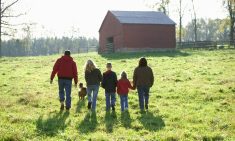Snow pelts the metal siding so hard it rattles, but inside the farm shop, it’s warm with work and energy. Lined up in various stages of maintenance are a truck, tractor and corn planter, while in the corner, pouring over their field maps, the three owners of H&M Farms near Altona, Man., discuss the upcoming season.
Today, like every day, Melvin Penner, Kyle Friesen and Kris Penner can sense the balance that is at the heart of this operation. Young optimism must work hand-in-glove with seasoned wisdom, technology with pragmatism, and business planning with the lessons learned from past battles.
Read Also

Producers aren’t panicking over tariffs and trade threats
The influence of tariff and trade uncertainity on farm business decisions.
Melvin Penner himself has been farming since 1975. At the time the farm was 560 acres. Today H&M Farms Ltd. grows canola, wheat, fall rye, oats, corn, soybeans, sunflowers and edible beans on about 22,500 acres. In 2003 Penner added a hog barn to diversify income, and now the farm includes an early wean multiplier 2,750-sow operation, and it finishes some gilts and barrows.
It means there’s a lot at stake with every decision. For Penner, more importantly, it also means there’s a lot at stake for a lot of people, as in the family and staff who make the farm successful, and who benefit from it.
Melvin’s son-in-law Kyle and nephew Kris are owner/ operators, and the farm employs 10-year round workers and hires about 15 seasonal workers. “It’s not all about expansion or money,” says Penner. “It’s about the person beside you.”
Penner also knows it takes preparation, communication and planning to dodge or at least deflect the bullets coming at today’s farms from so many directions. And, if you take a hit, to keep on going.
Expert farm business analysts agree, like Purdue ag economist Michael Boehlje, who sees a crucial distinction in the kinds of risks that today’s farms face.
Production, operational and financial risks can be managed with insurance and effective marketing, Boehlje writes in his paper Managing in Turbulent Times: Positioning to Capture the Upside, Buffer the Downside.
“But,” says Boehlje, “that is generally not the case with strategic risks.”
Yet Boehlje also argues that strategic risks and uncertainties can provide significant opportunities for profits and growth, so transferring them to others would result in lost opportunities.
Instead, managing these risks needs a different approach. It takes successful positioning to build the resiliency and absorptive capacity to handle the potential downside or negative consequences of an uncertainty, and it also takes agility to detect and capture the potential upside or positive consequences of an uncertainty.
In other words, learn how to take the bullet so it doesn’t kill you. Then sell the lead.
For Penner, many of the risks are just everyday facts. “Weather and market volatility are part of the game,” he says. “If you can’t be prepared for that, you shouldn’t be playing.”
But in today’s world, it takes a higher level of management, he says, so here’s how the management team at H&M Farms built armour plating with the goal to not only survive, but thrive.

1. Full capital utilization
Even when the income side of the balance sheet looks weak, using assets and leveraging your position can drive growth.
Penner remembers when the light bulb first came on. A neighbour had the same sugar beet harvester that he had, pulled by a similar tractor, all for a harvest that lasts only about one week a year. Then the two farms got together, sold one harvester and worked the other 24 hours a day, doubling their capital efficiency.
It was an indication this was a strategy to build on, he now says, especially if you’re willing to work with others.
Penner learned to think like this for everything in their business, from pickups to people. For instance, custom spraying creates a positive cash flow for their sprayer. They simply use this sprayer on their own farm and when done, do the custom run. When times are slow in custom spraying, they put the extra human resources to work somewhere else on the farm. They manage and match labour, carefully keeping the farm always current on their workload.
It does take a kind of alertness from management. Penner and the H&M team look and plan for efficiencies every day, in all parts of the business. “Think about every move,” Penner says. “Don’t just do it.”
To this point, they’ve always been expanding so they buy what equipment they need, but will need to address equipment turnover more carefully as the business matures.
They’ve also been renting whatever they can find, and buying whenever they have an opportunity. Over the years, Penner has generally run at about 35 to 40 per cent rent to owned land. “Rent-to-own ratio is kind of a fluid target,” Penner says. “If I could own all our land and it would cash flow it would be perfect. Normally rent is more cost-effective than owning, if you are only looking at cash flow.”
2. Low-cost production
Although the kinds of challenges that farming faces in the future may evolve, Penner is convinced one thing won’t change: if you are the best in class, you will come out on top.
Low-cost production matched with efforts to achieve the highest returns will always be a winning strategy. However, beyond direct expenses, many management factors have an impact on cost of production such as efficient capital and labour utilization, marketing, and scale. These top farm managers know every detail of their production costs, and they are constantly striving for better, more effective ways of doing things, keeping good records and combining their farm’s information with other sources to make decisions.
3. Contribution margins
Penner’s marketing strategy is to manage his margins, not to chase the absolute top price. This involves pricing on the spread between their cost of production and the market, not speculative pricing, and it has kept them in business in tough times even though he sometimes misses out on the big wins.
Penner summarizes it like this: “We didn’t make as much on hogs in 2014 as some farms, but in 2015 we still made money.”
It starts with a detailed understanding of their costs per bushel and per kilogram, and then comparing them against current cash market prices, futures market prices adjusted for local basis, or cash forward contract prices to lock in positive margins when opportunities to do so are available.
That may seem difficult for many farms, but positive margins are what can pay or “contribute to” fixed operating costs.
Marketing is also integrated with input purchases and with cash flows; however, selling needs to be done with logistics in mind.
In a hog context, Penner explains, it works like this: “Know your cost to produce the pigs, sell the pig, buy the inputs and target locking in margin.”
To market crops, Penner uses a basic incremental selling strategy. He direct contracts about 10 per cent of their acres. Depending on price and delivery, Penner then usually pre-sells about 25 per cent of projected harvest even before the team firmly decides exactly what crops and acres to grow. Another 25 per cent is sold when the crop goes in the ground, and then another quarter when they’re getting sure they’ve got a crop. Some are in paper trades and some are deferred delivery contracts. The 25 per cent balance he speculates on.
4. Diversification
In 2003 when Penner bought a neighbouring hog barn, he looked at it as a way to grow and also as a way to diversify for risk management strategy. The timing was right for the business to expand and the opportunity came up.
The strategy has levelled out cash flow for the whole farm. However, there has also been a lesson learned over the years. Each enterprise must be self-sustaining, Penner says. “One part of the business cannot carry the other.”
What Penner didn’t know was how challenging the hog business would become. Between 2006 and 2011, the number of hog farms fell by 35.9 per cent and the herd decreased 15.7 per cent, according to the 2011 Census of Agriculture. Influenza A (H1N1), incorrectly called “swine flu,” also damaged consumer confidence and closed some countries’ borders.
Penner quickly developed an appreciation for the differences between the grain and livestock businesses. “It certainly made life a lot busier,” he admits.
He learned the differences in how lending institutions treat the two sectors, and that there are a lot more options for financing in the U.S. “Banks will play a lot longer on black dirt than they will on a hog barn,” says Penner. “When the price of hogs is in the tank, the bankers don’t really want to own them.”
The farm survived the tumultuous hog market by tightly managing margins, building relationships, finding new opportunities and sometimes just rolling with the punches. Today, R12 Pork Ltd. is an early wean multiplier 2,750-sow herd for Danbred North America. The R12 barn has the ability to farrow 130 sows per week with a goal of shipping 1,400 weaned piglets per week, at about 20 days of age. The gilts are sold to commercial sow herds in the U.S., and barrows are sold locally.
Another diversification path has been to actively seek specialty crop opportunities. Currently H&M Farms grows an amazing array of crops, including winter wheat, fall rye, oats, corn, soybeans, sunflowers, and pinto, black and kidney beans.
Although the production risk and expertise is higher for growing some of these specialty crops, they cover it off with crop insurance. Not only do these crops deliver a premium, they create marketing opportunities and spread out workload and delivery for the farm.

5. Build trust
“If you can build trust, you can build relationships,” says Penner.
But that requires communication and what he calls “a 100-year view” of building for the future and not letting your thinking get bogged down with small problems.
Communicating with your creditors is extremely important. Every year H&M Farms sits down in the boardroom with the account managers of their two lenders to explain their game plan. They do an annual review together, so everyone knows the whole picture.
“It’s not what you’re saying that is important, but what the creditor understands,” says Penner.
As Penner approaches retirement, his son-in-law Kyle and nephew Kris Penner are taking over. Communication has become even more critical. Melvin mentors them and some staff, yet he’s happy to step back from making the day-to-day management decisions.
The key to succession is having a vision of what you want it to look like before you go to the lawyers, says Penner. To do that took years, not days, of talking and accepting that the process is fluid and things will change as you go along.
6. Adopt technology
“If there’s a fit for a new technology, we try it,” says Penner.
The younger generation at H&M Farms is driving the uptake of new computer-based technology. Already the farm has loads of gadgets and tools, including GPS yield mapping, satellite imagery, auto steer, variable rate application and even drones. This year they tried seeding 80 acres without a human touching the wheel. It worked perfectly.
Penner believes the technological revolution on farms is just starting, so they better be part of it even if it doesn’t necessarily pay back yet.
Penner says the drone they recently bought has been a good investment. One of their staff agronomists likes to use it, and with the size of their operation, it’s a tool for monitoring staging for weed control and fungicide applications. Also, when reviewing how seeding went, the drone images showed the operators the misses, an undisputable reminder how important it is to continually check their monitors.
Penner points out another angle to the technology question: if they don’t invest in technology, they will miss out on good employees who expect and want to engage with new technology.
In future, the technological skill of employees is going to be even more valuable for farmers, Penner believes. “Farming is going to need different people in the future,” he says. “In the past we needed a labour force that was mechanical and could operate machines — somebody who could change a 4020’s clutch was so valuable. In the future, maybe not so much.”
The clutch-changing employees will still be valued, Penner says, but “we will also need technologically talented people.”
7. Prepare for the worst
As much as you don’t like to think about it, Penner says farmers need to think about what could go wrong on your farm like accidents or spills and how they’d handle them. It’s why H&M Farms has a basic public relations strategy set up, just in case. Employees and management all know that if there’s a problem and the press wants to talk to someone on the farm, they’re not to say anything and direct the journalist to the president, Melvin, who will speak on the farm’s behalf. If the president isn’t available, they’re to direct them to Kyle.
It’s the things you can’t control or are not expecting that can derail a business, Penner says, so have a written agreement as a way to deal with death, disability, divorce and disagreements. Incorporation has also given them some more flexibility when transferring assets to the younger generation and with tax planning strategies.
You also need to think about what could happen with employees. Recently, H&M Farms created procedures to prevent and deal with employee sexual harassment claims.
The farm also carries insurance, including crop, life, health and accident and liability insurance. These policies are all part of a risk mitigation strategy.
8. Create a team of people
Good employees can increase your farm’s ability to withstand problems, says Penner. “We treat our employees like part of the team.”
The farm offers full-time employees a comprehensive benefits package, plus pension plan contributions after one year.
They cross-train staff so if anyone is absent, someone else can step in and do the job. This also keeps people learning and engaged. They have written job descriptions, and an on-board training and mentoring process.
Penner also finds it’s just as important to listen and give them the opportunity to contribute.
“Annual reviews are a very good way to learn what is going on in their heads, but I try not to do a ‘performance’ review as they already normally know if they are doing what is expected,” he says.
Penner has high expectations and everyone knows it. But that imposes a responsibility: the leadership team must communicate why the company is doing what it is doing.
“We try to give our employees a clear direction as to where we are headed and their role in helping us get there,” Penner says. “They are also our ambassadors, and they need to understand that.”
Absorb and be agile
Below are key recommendations from Purdue ag economist Michael Boehlje’s paper Managing in Turbulent Times: Positioning to Capture the Upside, Buffer the Downside (available via purdue.edu).
Boehlje includes an assessment tool to test your farm’s ability to absorb bad news and to be agile. At the very least, it will get you thinking.
The following 10 characteristics, Boelhje says, will equip your farm to accommodate and absorb unfortunate events.
- Low fixed costs — These can help a farm weather a wide range of changes, such as price wars, higher raw material costs, and declining demand.
- War chest of cash — Cash can be deployed against future contingencies that you cannot foresee. In Canada, AgrInvest can be an important tool.
- Diversified cash flow — Diversification can help you withstand downturns in specific markets, and inventories can serve as a store of potential wealth that can be sold later.
- Too big to fail — Large firms can survive by off-loading operations and reducing assets in crises. Size also increases the odds the government, customers, or suppliers will prop up an ailing business.
- Tangible resources — Valuable resources like real estate serve as a store of potential value.
- Intangible resources — Brand expertise and technology can insulate the farm against changes in the market in the short and medium term.
- Customer lock-in — Prevent customers from easily jumping ship. Pump up service and look hard at pricing
- Protected core market — Barriers to entry in a core market provide a safe stream of cash to weather storms.
- PowerfuL patron — A powerful government, regulator, customer, or investor vested in the firm’s success can buffer it from changes.
- Excess staff — The corporate equivalent of body fat, these employees serve as a store of value that can be shed in tough times. Railroad executives have been doing it for years.















